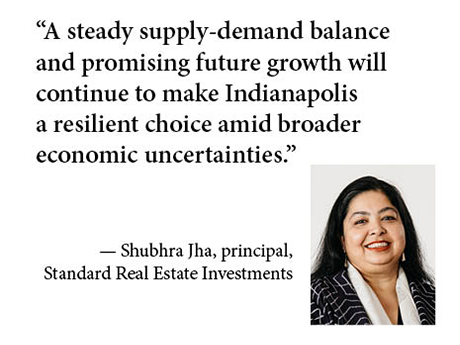With a new presidential administration comes new policies and new economic uncertainties. But trying times such as these are no match for the consistency of the Indianapolis multifamily market. The metropolitan area’s “steady eddie” performance and resiliency during the tumultuous period of the COVID-19 pandemic has proven its staying power.
Population, Job Growth Signal New Opportunities
Metro Indianapolis, with a population base of 2.2 million people, experienced a sizeable population increase over the past four years. The metro area added more than 85,000 people during that period, with a good mix of domestic and international migration.
There are three main drivers of Indianapolis’ strong market dynamics: affordability, diversity and a business-friendly regulatory environment. These factors have been a significant draw, particularly for businesses and new residents hailing from Illinois.
A diverse range of business sectors drive employment in Indianapolis, from agribusiness to manufacturing to both regional and national trade and distribution. This is the basis for the metro area’s trademark low volatility and lower risk profile.
In January 2025, the Indianapolis metro area recorded a modest increase of 0.4 percent year-over-year in total non-farm employment.
In February, the unemployment rate for the Indianapolis metro area was a low 4 percent, virtually unchanged from a year ago, and lower than the U.S. unemployment rate of 4.2 percent for the same period.
Leading employers in the city include educational institutions such as Indiana University, Purdue University, Marian University, Butler University and the Indiana University (IU) School of Medicine, as well as pharmaceutical and health care companies Elevance Health, Eli Lilly and Roche Diagnostics.
The city is also seeing a surge in advanced manufacturing development, particularly in areas such as automation, robotics and 3D printing. A skilled labor pool and strong logistics infrastructure has driven investment in technology to fuel this growth.
Infrastructure Investments Support Future Growth
The foundation of Indianapolis’ solid performance draws from its rich pool of talent, which is in turn supported by the state’s strength in higher education.
IU School of Medicine is expanding into a new $230 million education and research building as part of a larger $4.3 billion investment by IU health campus in the area north of downtown Indianapolis. The mixed-use development will offer medical facilities and education space, as well as dining, retail and entertainment options.
The excitement created by this project was a key driver in the sale of Wesley Place, which Standard Real Estate Investments (Standard) and Arrow Street Development (Arrow) divested of in late 2024.
Standard developed the community in partnership with Arrow and Belay Investment Group. Wesley Place consists of 244 units, as well as 3,000 square feet of street-level retail space and parking for 327 vehicles. Amenities include a game room, resident lounge, pet spa, fitness center, bike storage and an interior courtyard with a pool deck. The property is the only luxury rental residence in the Medical District.
Wesley Place was 91 percent occupied at the time of the sale, which took place months after the development team delivered the community.
Additionally, companies such as Eli Lilly Co. are pouring substantial capital into developing research and development and manufacturing facilities within the LEAP Lebanon Research and Innovation district, a 9,000-acre mixed-use development situated just outside the Indianapolis suburb of Lebanon.
Novartis has also established a $200 million manufacturing facility in Indianapolis, further cementing the metro as a pharmaceutical manufacturing hub.
The metro Indianapolis region is also seeing growth in its tourism and entertainment sectors. Major projects include the expansion of the Indiana Convention Center, the addition of a new 800-room hotel connected to the convention center, and the renovation of the Indianapolis Motor Speedway Museum.
The Apartment Sector Will Stabilize
Indianapolis is attractive to graduates and migrants due to its relative housing affordability. There is a lack of onerous regulatory constraints on housing development in the city, which has enabled the metro to remain affordable for renters, homeowners and businesses.
These factors can sometimes be double-edged swords for the rental housing market, as they can lead to unconstrained supply growth as well as loss of renters to homeownership. However, growth in the student, young household and immigrant renter cohorts in recent years has proven to be an enduring demand booster for multifamily housing in Indianapolis.
For decades prior to 2023, developers delivered between 2,000 and 2,500 units annually to the city of Indianapolis. In both 2023 and 2024, however, more than 6,000 units came online. This uptick in the pace of development was in response to historically low vacancy rates in the city, which were in the mid-5 percent range in 2021. This surge skewed the supply-demand equilibrium in the short term, causing vacancies and concessions to rise. But as this surge in supply wanes, market fundamentals are recovering.
Construction starts in 2024 were down 53 percent compared with prior years, due to a general pullback in lending activity. This has effectively set up the multifamily housing market in Indianapolis to see a significantly reduced supply pipeline after the current slate of deliveries are completed.
Standard predicts that metro Indianapolis will see solid and stable market fundamentals, as well as above-inflation rent growth, heading into 2026. There continues to be a need for newer, more efficient multifamily stock while going-in yields that are above average help provide a tailwind for risk-adjusted returns.
A steady supply-demand balance and promising future growth will continue to make Indianapolis a resilient choice amid broader economic uncertainties. The metro’s affordability, robust job market and strategic infrastructure investments make it an attractive market for long-term investment.
— Shubhra Jha is a principal and head of investment strategy and research for Los Angeles-based Standard Real Estate Investments, which has been active in recent Indianapolis trades. Jha can be reached at [email protected]. This article originally appeared in the March/April issue of Midwest Multifamily & Affordable Housing.


